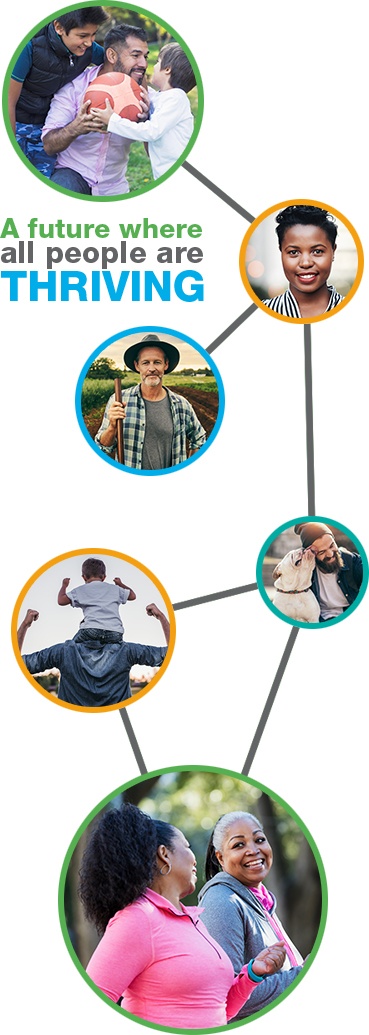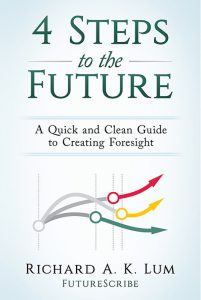FORESIGHT is...
The U.S. health system is broken. Americans pay too much for poor health outcomes and the health inequities within our country are glaring. While politicians respond by quibbling about who’s going to pay for our current system of care, what we really need is a radical rethinking of health that goes beyond health care to include all of the factors that contribute to a person’s well-being.
FORESIGHT is a nationwide, collaborative effort to equitably envision and create a new future for health and well-being. We have looked at the big forces that will impact our health in the future. Game changing trends tell us that things like climate change, pandemics, and powerful technologies will continue to change our world in unexpected ways. Now, we are listening to thousands of people—especially those whose voices are rarely heard—who are looking at these trends to identify a fresh vision and bold new ideas for shaping the best possible outcomes, starting right now.
With a better understanding of possible futures, a clearer sense of priorities, and a set of bold ideas, FORESIGHT will work with people and organizations across the United States to start making their vision for health and well-being a reality. This will require new partnerships and mindsets, a different allocation of resources, and a radical openness to experimentation. It will also require us to recognize that communities are different and therefore how they need to implement the vision will be different.
FORESIGHT is an initiative of 17 philanthropic partners led by The Rippel Foundation, created in partnership with Blue Shield of California Foundation, and closely advised by people representing a diversity of sectors who are ready to uncover and implement new ideas to address our nation’s growing challenges around health and well-being.

The world is changing fast.
It’s time we design a future for health together.
Our work begins with FORESIGHT.
The Process
The process of gaining foresight is disciplined but rewarding. FORESIGHT is a nationwide, collaborative effort to equitably envision and create a new future for health.
In the first part of Phase 1, we looked at the big forces that will impact our health in the future. Game changing trends tell us that things like climate change, pandemics, and powerful technologies will continue to change our world in unexpected ways. Now, we are listening to thousands of people—especially those whose voices are rarely heard. They are looking at these trends to identify fresh ideas and a bold new vision for shaping the best possible outcomes, starting right now.
In Phase 2, with a better understanding of possible futures, a clearer sense of priorities, and a set of bold ideas, FORESIGHT will work with people and organizations across the United States to start making their vision for health and well-being a reality. This will require new partnerships and mindsets, a different allocation of resources, and a radical openness to experimentation.
What is an emergent process?
FORESIGHT’s ProcessClick on the icons below to learn more about each step. Information will show below the graphic.
Futures Scanning
FORESIGHT uses a futuring process with Futures Scanning and Scenario Planning techniques. These help us develop a shared understanding of what forces will impact our system for health and well-being, and what actions we can take to obtain the desired future. Our team of futurists has identified nine “Game Changers” that could alter the future of health—including the infusion of machines into all aspects of life, the simultaneous rises of authoritarianism and citizen-led movements, and the breakdown of our environment due to climate change. These were derived from FORESIGHT’s more comprehensive Futures Scanning report.
Read on to learn more about the Futures Scanning process. Jump over to scenarios of possible futures to see how the Game Changers have evolved into stories that 8,000 people will react to in our resident engagement process.
some title here
Expected Outcomes
- Shared aspirations for a new future for health and well-being in the United States become a rallying cry for action across the country. In this new future, the health and well-being of all Americans is valued and well supported.
- Regional leaders who are committed to developing, enacting, and evolving strategies to localize the national vision in their regions.
Leaders see this as doing their part to achieve the common aspirations. The leaders could be from a diversity of sectors and include residents directly involved with FORESIGHT who work together to ensure their plans and actions reflect what FORESIGHT helped cultivate:
- Broadening understanding of the drivers of health disparities
- Increasing commitment to systemic, longitudinal change
- Growing dedication to investing in ways that will bring about the common aspirations and localized visions
- Willingness to dive deeply into critical new conversations that advance the bold actions needed to enact the localized visions
- Drive to vulnerably connect with other regions engaging in this work to unite through common experience and make improvements based on what is being learned
If FORESIGHT is successful, it will also contribute to the following implications over time:
- More and more regions develop localized visions based on the common aspirations and engage in their own strategies to improve health and well-being.
- State and federal policymakers support regions by enacting new policies and strategies that support this work.
- There is radically transformed health and well-being in the regions engaged in this work.
